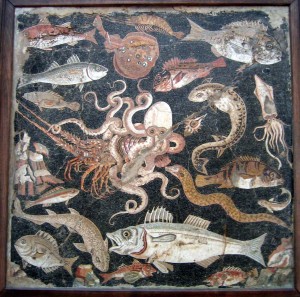The Oddest & Weirdest Pets of Ancient Rome Posted by Brittany Britanniae on Aug 7, 2014 in Latin Language, Roman culture
The bond between humans and pets is an interesting and odd bond. The love and friendship that transgress species is an interesting relationship that deserves special attention. Most of us are familiar with the ever persisting sites that our friends show us the most unlikely of friends. These examples range from dogs and chimps, tigers and pigs, cats and birds, and so on. I am hopeful that this post will show that these odd and weird bond existed even in Ancient Rome between man and beast. The order is from the least odd to the most bizarre (in my opinion).
Historical Person: Julius Caesar
Pet: Giraffe
Name: He didn’t even bother…. ( I assume)
Love: 3 out of 10 hearts.
Why: In 48 BC, Julius Caesar embarked on a campaign where he eventually started his affair with Queen Cleopatra. Before leaving her, he decided to bring back a sundry of exotic beasts including lions, panthers and green monkeys. The most strange one was long-necked creature known as a giraffe. The Romans saw it as half camel and half panther (due to its spots). Perhaps he brought the beast back to remind him of Cleopatra or perhaps he simply liked it.
Habits: The historian Pliny thought the giraffe was a “wild sheep.” Whatever the case, Caesar soon grew bored with his “pet.” He fed the giraffe to the lions in a Coliseum in front of a baying Roman public; his gesture (offering up his pet as a prize) may have been a sign of his wealth and magnanimity. This is somewhat sad though.
Sources: Pliny, Strabo
Historical Person: Caligula
Pet: Horse
Name: Incitatus
Love: 6 out of 10 hearts
Why: There is much speculation amongst historians as to why Calgula prized his pet horse so much. While it should be stated that his horse was a race horse- perhaps its victory and magnificence were contributors to Caligula’s fondness for it. Or perhaps, he liked the horse for its ability to ridicule and embarrassed his subjects. I am afraid we will never know for sure.
Habits: Incitatus had a stable of marble, an ivory manger, purple blankets, and a collar of precious stones. Dio Cassius has indicated that the horse had its own servants, and was fed food mixed with gold flake. How wasteful! Suetonius also wrote that it was said that Caligula planned to make Incitatus a consul. Furthermore, the horse “invite” dignitaries to dine with him in a house outfitted with servants there to entertain such events.
Sources: Suetonius, Cassius Dio

An array of creatures that may have been found in a “piscine.” Sea creatures mosaic ( Attention to the Eel near the right bottom corner) from Pompeii; National Archaeological Museum of Naples, Italy. Courtesy of WikiCommons & Massimo Finizio.
Historical Person(s): Quintus Hortensius (Famous Orator), Antonia (Daughter of Marc Antony, Niece of Augustus and Mother of Emperor Claudius) , Crassus (either Marcus Licinius Crassus [defeated Spartacus] or Lucius Licinius Crassus [orator and censor in 92 BC].
Pet: Eels or Murena
Names: Unrecorded
Love: 8 out of 10 hearts
Why: Probably initially raised for food (as was the case for Gaius Hirrius, the first person to have ponds solely for raising eels, supplied six thousand to Caesar for his triumphal banquets); their evolution to beloved pets must have been gradual and somewhat of an acquired taste.
Habits: The orator, Quintus Hortensius, is said to have wept when his favorite murena died. Another pet murena, kept there by Antonia, the niece of Augustus, was adorned with earrings, which prompted some to visit and see the oddity. Crassus, too, was said to have adorned a pet eel with earrings and small necklaces “just like some lovely maiden,” training it to respond to its name and swimming up to eat what was offered.
Sources: Aelian, Plutarch, Macrobius, Varro
Historical Person: Virgil
Pet: House Fly
Name: I don’t believe it was named.
Love: 9 out of 10 Hearts (Virgil must have surely loved it!)
Why: In reality, Virgil didn’t keep a fly as a pet, but conveniently found one to be his pet. This is due to the fact that he discovered that the government was planning to confiscate the lands of the rich (i.e: his lands too!), and give them to war veterans, except for those lands that contained mausoleums. So Virgil the clever poet he was had an idea. Virgil held an incredibly lavish funeral (with mourners, an orchestra, invited celebrities and lots of poetry reading) organized for “pet.” Then, the poor insect’s body was buried in an expensive mausoleum. The whole thing costed Virgil about 800.000 sesterces ( approx. $1.6 million).
Habits: I assume if one had a pet fly- buzzing around your ears and eating garbage would be part of their habits. However, it would seem as if this doesn’t matter in the case of Virgil. Humorously it said that Virgil coined the expression “time flies” (tempus fugit).
Sources: Suetonius
HONORABLE MENTION
Pet: Tigress
Name: Phoebe
Why: It is said that Nero first saw her fighting in a Colloseum, where he was impressed by her ruthlessness. For she was said to cause more havoc than three other tigers combined. Thus, Nero decided to spare her life and keep her as his personal companion. He named her Phoebe.
Habits: He had his servants build a golden cage for her in the palace grounds, but she wasn’t locked up all the time. She was allowed to roman around and even when the Emperor had guest at his table! Of course, anyone who annoyed or irritated Nero in any way would end up as Phoebe’s dessert. It is also said that she was trained by a famous animal trainer which allowed Nero to eat from her hand!
Sources: None that I could find; thus this is a honorable mention.
=

Build vocabulary, practice pronunciation, and more with Transparent Language Online. Available anytime, anywhere, on any device.
About the Author: Brittany Britanniae
Hello There! Please feel free to ask me anything about Latin Grammar, Syntax, or the Ancient World.







Comments:
Colin Gough:
Really enjoyed these thank you
agen sabung ayam:
I’ve read a few good stuff here. Certainly worth bookmarking for revisiting. I surprise how much effort you put to make such a excellent informative web site.